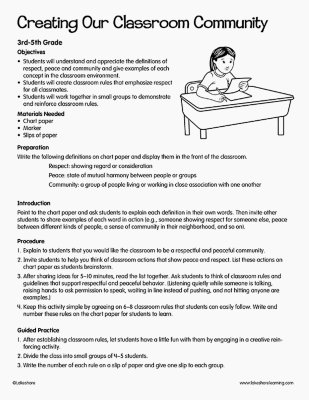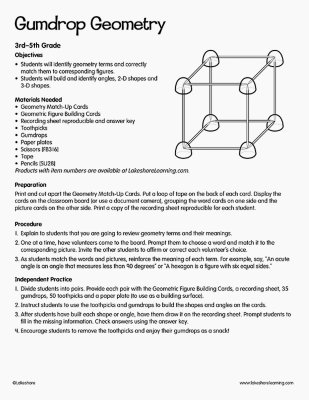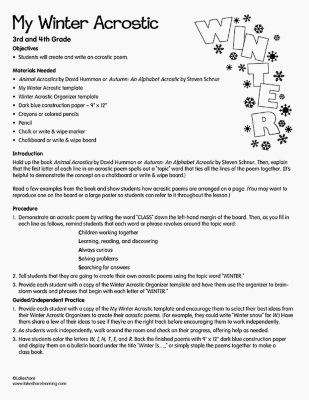Narrow by Grade
- Infant (0)
- Toddler (0)
- Preschool (0)
- Pre-K (0)
- Kindergarten (0)
- 1st (0)
- 2nd (0)
- 3rd (2)
- 4th (3)
- 5th (2)
- 6th & Up (0)
Grade
Narrow by Age
- 0-18m (0)
- 18-36m (0)
- 3 yrs. (0)
- 4 yrs. (9)
- 5 yrs. (9)
- 6 yrs. (2)
- 7 yrs. (2)
- 8 yrs. (2)
- 9 yrs. (3)
- 10 yrs. (2)
- 11 yrs. & Up (0)
Age 9 yrs.
3 results for "classroom posters"
Filters
Clear All
Creating Our Classroom Community
3rd Grade - 5th Grade
Objectives Understanding and appreciating the definitions of respect, peace and community, and giving examples of each concept in the classroom environment Creating classroom rules that emphasize respect for all classmates Working together in small groups to demonstrate and reinforce classroom rules Describing people, places, things and events with relevant details, expressing ideas and feelings clearly Materials Needed Chart paper Marker Slips of paper Introduction Point to the chart paper and ask students to explain each definition in their own words. Then invite other students to share examples of each word in action (e.g., someone showing respect for someone else, peace between different kinds of people, a sense of community in their neighborhood).
View Lesson PlanGumdrop Geometry
4th Grade
Objectives Students will identify geometry terms and correctly match them to corresponding figures. Students will build and identify angles, 2-D shapes and 3-D shapes. Materials Needed Geometry Match-Up Cards Geometric Figure Building Cards Recording sheet reproducible and answer key Toothpicks Gumdrops Paper plates Scissors Tape Pencils Preparation: Print and cut apart the Geometry Match-Up Cards. Put a loop of tape on the back of each card. Display the cards on the classroom board (or use a document camera), grouping the word cards on one side and the picture cards on the other side. Print a copy of the recording sheet reproducible for each student.
View Lesson PlanMy Winter Acrostic
3rd Grade - 5th Grade
Objectives Reading: Literature Reading and comprehending grade-appropriate literature, including stories, dramas, and poetry Writing Writing an acrostic poem Materials Needed Animal Acrostics by David Hummon or Autumn: An Alphabet Acrostic by Steven Schnur My Winter Acrostic template Winter Acrostic Organizer template Dark-blue construction paper - 9" x 12" Crayons or colored pencils Pencil Chalk or write & wipe marker Chalkboard or write & wipe board Introduction Hold up the book Animal Acrostics by David Hummon or Autumn: An Alphabet Acrostic by Steven Schnur. Then explain that the first letter of each line in an acrostic poem spells out a “topic” word that ties all the lines of the poem together. (It’s helpful to demonstrate the concept on a chalkboard or write & wipe board.) Read a few examples from the book and show students how acrostic poems are arranged on a page. (You may want to reproduce one on the board or a large poster so students can refer to it throughout the lesson.)
View Lesson Plan

